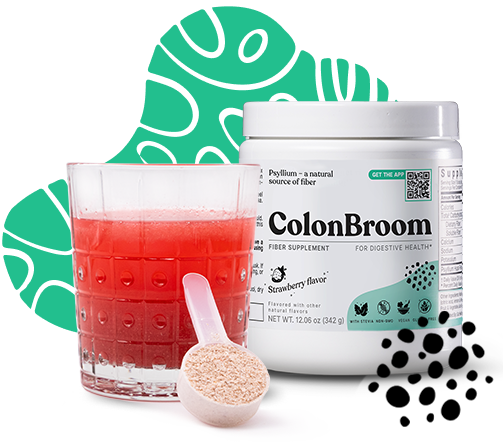Weight management is a concern for many, and the key might be hiding in the foods we eat every day. Unraveling the mystery of fiber, this article dives deep into how fiber can help your weight loss journey.

Contents
What Is Dietary Fiber?
Dietary fiber, often simply referred to as fiber, is an essential nutrient derived from plant foods.
Unlike other food components such as fats, proteins, and carbohydrates, which our bodies digest and absorb, fiber remains relatively intact as it moves through the digestive system. This unique characteristic provides a wealth of health benefits, including aiding digestive system function and supporting heart health.
Most Common Dietary Fiber Types and Their Roles

Within the world of dietary fiber, there are two main players: soluble and insoluble fiber. Each type offers unique benefits and can be found in various foods, playing a crucial role in our overall health and weight management:
Soluble fiber
Soluble fiber is a type of fiber that dissolves in water, creating a gel-like substance. This transformation process in our digestive system can help lower blood cholesterol and stabilize blood sugar levels, aiding those with or at risk of diabetes.
Foods rich in soluble fiber include oats, beans, lentils, apples, and citrus fruits. Beyond its heart-healthy benefits, soluble fiber, especially the viscous fiber sub-type, plays a significant role in weight management. It offers a feeling of fullness and satiety, ensuring that we consume fewer calories and, thus, helping us lose weight.
Insoluble fiber
Unlike soluble fiber, insoluble fiber doesn’t dissolve in water. Instead, it adds bulk to our diet, aiding in regular bowel movements and preventing constipation. This type of fiber acts as a natural detoxifying agent, ensuring the smooth passage of food and waste products through our digestive system.
Prime sources of this type of fiber include whole grains like wheat and barley, the skin of fruits and vegetables, wheat bran, nuts, beans, cauliflower, and brussels sprouts. While its weight loss benefits are often understated, having a regulated digestive system can indirectly aid in weight control, preventing issues like bloating.
Does Fiber Help You Lose Weight?

Yes, fiber plays a significant role in weight management. When consumed, soluble fibers, particularly viscous fiber, absorb water and expand in the stomach. This expansion can create a feeling of fullness, leading to reduced food intake and fewer consumed calories – key components of successful weight loss.
Moreover, high fiber foods tend to be more filling without the extra calories, so you’re likely to eat less and stay satisfied longer. The connection between increased fiber intake and losing weight has been consistently supported by numerous studies.
Does a Bigger Fiber Intake Boost Metabolism?
The relationship between intake of fiber and metabolism is intricate. Consuming fiber, especially soluble fiber, can help stabilize blood sugar levels, thus potentially reducing insulin spikes that can lead to fat storage.
While fiber itself doesn’t directly speed up metabolism, it does promote better gut function. A balanced gut microbiome, fostered by a diet rich in fiber, can positively influence metabolism and overall weight management due to also eating fewer calories.

What Are the Health Benefits of a High Fiber Diet?
Dietary fiber is more than just aiding in weight management; its advantages span across various health dimensions. Let’s dive into these benefits:
-
Heart health
A high fiber diet promotes a healthy heart by paving the way for healthier cholesterol levels. By incorporating foods rich in fiber, one can potentially lower risk of heart disease.
-
Blood sugar regulation
Consuming fiber can profoundly influence insulin resistance. This is crucial for individuals with diabetes or those at potential risk. Soluble fibers, commonly found in oats and legumes, decelerate sugar absorption, refining blood glucose levels.
-
Digestion
Insoluble fiber aids in propelling food through the intestines, alleviating constipation, and endorsing regular bowel movements. Soluble fiber, acting as a prebiotic, nourishes the beneficial gut bacteria. This contributes to a harmonious gut microbiome, vital for optimal gut health.
-
Disease prevention
A fiber-rich diet can diminish the risk of conditions like metabolic syndrome, colorectal cancer, and diverticular disease. By relishing in foods rich in fiber, you’re not merely facilitating your body’s natural functions but also erecting a defense against numerous illnesses.
Potential Side Effects of Excessive Fiber Intake

While the benefits of fiber are undeniable, it’s essential to strike a balance. Overconsumption of fiber in a short period can lead to digestive issues like bloating, gas, temporary weight gain, and cramping.
Additionally, consuming too much fiber without adequate hydration can lead to constipation. Therefore, it’s always advisable to gradually increase your intake of fiber and ensure you drink plenty of water alongside.
How Much Fiber Do You Need?
The recommended daily fiber intake varies based on age, sex, and overall health. However, general guidelines suggest that adult women should aim for about 21 to 25 grams of fiber daily, while men should aim for about 30 to 38 grams.
How to Include More Fiber in Your Diet?

Incorporating more fiber into your regime doesn’t require a significant overhaul. Many delicious foods are naturally packed with fiber. Let’s delve into some fiber-rich options across various categories:
Fruits and vegetables
When looking to boost your intake of fiber for body weight management, fruits and vegetables are the gold standard. These plant foods are naturally nutrient dense, offering a myriad of benefits beyond their fiber content. Here are five standout options:
- Fresh berries: Offering about 5.3 grams of fiber per 100 grams, these fruits are not only delicious but also high in antioxidants that promote good health.
- Brussels sprouts: Providing around 3.8 grams of fiber per 100 grams, they’re also rich in vitamins K and C.
- Broccoli: Contains approximately 2.6 grams of fiber per 100 grams and is known to support a healthy heart.
- Avocado: Packs around 6.7 grams of fiber per 100 grams and is also a source of healthy fats.
- Spinach: Has about 2.2 grams of fiber per 100 grams and is rich in iron and calcium.
Nuts and seeds
Nuts and seeds are powerhouses when it comes to fiber and other essential nutrients. Their compact nature makes them an easy and tasty way to sneak more fiber into your diet, aiding in weight control.
- Almonds: Delivering a robust 12.5 grams of fiber per 100 grams, they’re also high in vitamin E and magnesium.
- Chia seeds: With a staggering 34.4 grams of fiber per 100 grams, they’re additionally loaded with omega-3 fatty acids and calcium.
- Flaxseeds: Offer around 27.3 grams of fiber per 100 grams and are known for their heart-healthy properties.
- Pumpkin seeds: Contain approximately 18.4 grams of fiber per 100 grams and are a good source of zinc.
- Sunflower seeds: Provide around 8.6 grams of fiber per 100 grams and are rich in vitamin E.
Whole grains
Whole grains are a cornerstone in healthy eating patterns worldwide. Rich in dietary fiber and other essential nutrients, they play a pivotal role in maintaining body weight and promoting gut function.
- Quinoa: This grain gives about 2.8 grams of fiber per 100 grams and is also a complete protein, containing all nine essential amino acids.
- Barley: Contains around 17.3 grams of fiber per 100 grams and supports healthy cholesterol levels.
- Oats: Offer approximately 10.6 grams of fiber per 100 grams and are known to maintain steady blood glucose levels.
- Brown rice: Packs around 3.5 grams of fiber per 100 grams and is a staple in many healthy foods.
- Whole wheat pasta: Provides about 10.7 grams of fiber per 100 grams, offering a healthier alternative to regular pasta.
Other fiber sources
While many turn to traditional foods, there are alternative sources that can be invaluable, especially when following specific diets or facing dietary restrictions.
Psyllium husk stands out among these sources. It’s a form of soluble fiber derived from the seeds of the Plantago ovata plant. Consuming psyllium husk can help you lose weight by promoting feelings of fullness, regulating blood sugar, and supporting a healthy digestive system.

Moreover, it’s a primary ingredient in products like ColonBroom, which is designed to boost one’s intake of fiber, making it easier for individuals on specific diets like keto to get enough fiber.
The Science Behind Fiber and Weight Loss: Key Takeaways
Fiber’s role in weight loss and overall health is undeniable. Consuming adequate amounts of both types of fiber can lead to numerous health benefits, from improved digestive system health to reduced risk of chronic diseases. As research continues to unravel the relationship between fiber and weight, one thing is clear: this nutrient is essential for a healthy lifestyle and optimal weight management.
Related articles

How to Debloat Fast: Natural Remedies, Tips & Tricks
Are you tired of feeling bloated and uncomfortable? Whether it's an important event, a beach day, or simply the desire to regain a light and refreshed feeling, knowing how to debloat fast can be a game-changer. Bloating is a common issue, but you don't have to let it hold you back. In this article, we'll explore the science behind bloating, the primary causes, and, most importantly, practical steps to achieve instant relief.

How to Heal My Gut Naturally: The Comprehensive Guide
Achieving optimal gut health is paramount for overall well-being. In this comprehensive guide, we will explore the intricate relationship between digestive wellness and your body's overall health. Discover actionable strategies to heal your gut naturally, improve digestive function, and cultivate a thriving microbiome.

Unlocking a Healthier You: The Proven Science Behind ColonBroom Premium’s Success
This task becomes even more daunting considering the dietary habits prevalent in the USA. A significant number of Americans struggle to meet their daily fiber requirements, leading to issues like constipation, bloating, and difficulties in weight management. Amidst this backdrop, ColonBroom Premium emerges as a beacon of hope. This supplement is not just another addition […]
Take a quiz and get your personalised solution.





